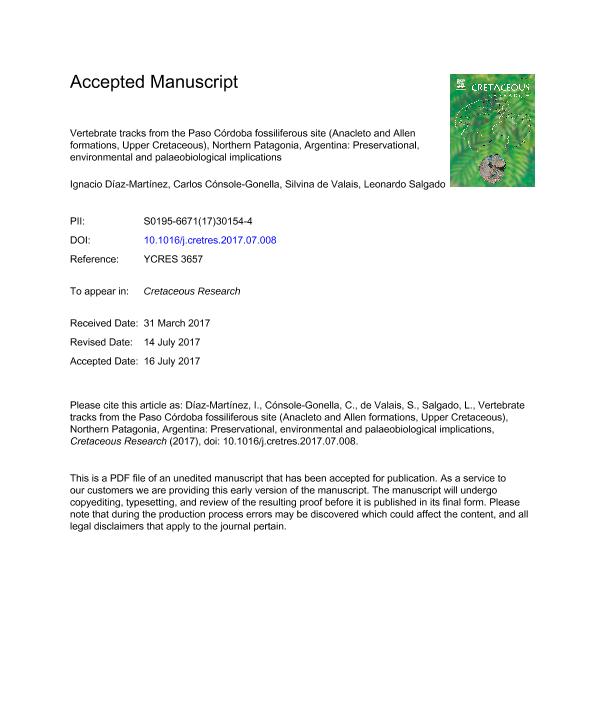Mostrar el registro sencillo del ítem
dc.contributor.author
Díaz Martínez, Ignacio

dc.contributor.author
Cónsole Gonella, Carlos Alfredo

dc.contributor.author
de Valais, Silvina

dc.contributor.author
Salgado, Leonardo

dc.date.available
2018-12-12T19:42:21Z
dc.date.issued
2018-03
dc.identifier.citation
Díaz Martínez, Ignacio; Cónsole Gonella, Carlos Alfredo; de Valais, Silvina; Salgado, Leonardo; Vertebrate tracks from the Paso Córdoba fossiliferous site (Anacleto and Allen formations, Upper Cretaceous), Northern Patagonia, Argentina: Preservational, environmental and palaeobiological implications; Academic Press Ltd - Elsevier Science Ltd; Cretaceous Research; 83; 3-2018; 207-220
dc.identifier.issn
0195-6671
dc.identifier.uri
http://hdl.handle.net/11336/66358
dc.description.abstract
The Paso Córdoba fossiliferous site (Río Negro, Northern Patagonia) is one of the first Mesozoic fossiliferous localities studied in Argentina. There, turtle, crocodile and dinosaur remains as well as dinosaur and bird tracks have been recorded. Recently, a new locality with vertebrate tracks, the Cañadón del Desvío, has been discovered in Paso Córdoba. Six track-bearing layers were located in outcrops belonging to the Anacleto (lower to middle Campanian, Neuquén Group) and Allen (middle Campanian-lower Maastrichtian, Malargüe Group) formations. The Cañadón del Desvío locality reveals that vertebrate trace fossils are distributed in two distinct environments, floodplains of a meandering fluvial to shallow lacustrine system and a wet interdune deposit that is associated to an aeolian setting. Also, in the logged section several soft sediment deformation structures were found. In regard of this, a sedimentary facies analysis is provided in order to assess the palaeoenvironmental implications of this new record. The analysed tracks are preserved in cross-sections, on bedding-planes and as natural casts. When it is possible, the tracking surface, true tracks, undertracks and overtracks/natural casts have been identified and the track preservation and the formation history of the tracksite are discussed. Only two tracks preserve enough anatomical details to relate them with their trackmakers, in this case hadrosaurid dinosaurs. The stratigraphical, facial and palaeoenvironmental data of this study support the idea of a transitional passage between the Anacleto and Allen Formation in Paso Córdoba. The presence of hadrosaurid dinosaur tracks suggests that the upper part of the log, where this kind of tracks were found, likely belong to Allen Formation due to this dinosaurs appear in the Southern Hemisphere in this epoch. The sum of osteological and ichnological remains improve the Paso Córdoba palaeofaunistic knowledge. The presence of six different levels in which the trackmakers walked reflects the abundance of vertebrates in the transition between Anacleto and Allen formations.
dc.format
application/pdf
dc.language.iso
eng
dc.publisher
Academic Press Ltd - Elsevier Science Ltd

dc.rights
info:eu-repo/semantics/embargoedAccess
dc.rights.uri
https://creativecommons.org/licenses/by-nc-nd/2.5/ar/
dc.subject
Argentina
dc.subject
Campanian-Maastrichtian
dc.subject
Palaeodiversity
dc.subject
Sedimentary Structures
dc.subject
Vertebrate Ichnology
dc.subject.classification
Meteorología y Ciencias Atmosféricas

dc.subject.classification
Ciencias de la Tierra y relacionadas con el Medio Ambiente

dc.subject.classification
CIENCIAS NATURALES Y EXACTAS

dc.title
Vertebrate tracks from the Paso Córdoba fossiliferous site (Anacleto and Allen formations, Upper Cretaceous), Northern Patagonia, Argentina: Preservational, environmental and palaeobiological implications
dc.type
info:eu-repo/semantics/article
dc.type
info:ar-repo/semantics/artículo
dc.type
info:eu-repo/semantics/publishedVersion
dc.date.updated
2018-10-23T17:52:27Z
dc.journal.volume
83
dc.journal.pagination
207-220
dc.journal.pais
Estados Unidos

dc.description.fil
Fil: Díaz Martínez, Ignacio. Consejo Nacional de Investigaciones Científicas y Técnicas. Centro Científico Tecnológico Conicet - Patagonia Norte. Instituto de Investigación en Paleobiología y Geología; Argentina. Universidad Nacional de Río Negro; Argentina
dc.description.fil
Fil: Cónsole Gonella, Carlos Alfredo. Consejo Nacional de Investigaciones Científicas y Técnicas. Centro Científico Tecnológico Conicet - Tucumán. Instituto Superior de Correlación Geológica. Universidad Nacional de Tucumán. Facultad de Ciencias Naturales e Instituto Miguel Lillo. Departamento de Geología. Cátedra Geología Estructural. Instituto Superior de Correlación Geológica; Argentina
dc.description.fil
Fil: de Valais, Silvina. Consejo Nacional de Investigaciones Científicas y Técnicas. Centro Científico Tecnológico Conicet - Patagonia Norte. Instituto de Investigación en Paleobiología y Geología; Argentina. Universidad Nacional de Río Negro; Argentina
dc.description.fil
Fil: Salgado, Leonardo. Consejo Nacional de Investigaciones Científicas y Técnicas. Centro Científico Tecnológico Conicet - Patagonia Norte. Instituto de Investigación en Paleobiología y Geología; Argentina. Universidad Nacional de Río Negro; Argentina
dc.journal.title
Cretaceous Research

dc.rights.embargoDate
2020-04-01
dc.relation.alternativeid
info:eu-repo/semantics/altIdentifier/url/https://www.sciencedirect.com/science/article/pii/S0195667117301544
dc.relation.alternativeid
info:eu-repo/semantics/altIdentifier/doi/https://doi.org/10.1016/j.cretres.2017.07.008
Archivos asociados
